Compensation and Benefit Report: University Employee Compensation
VerifiedAdded on 2021/04/17
|11
|962
|79
Report
AI Summary
This report delves into the critical role of compensation and benefits in fostering organizational growth and employee productivity. It emphasizes the importance of establishing internal pay and equity scales to ensure fair compensation for employees at different levels. The report uses a job factor and point system to evaluate job positions, highlighting the need for equitable pay based on performance and skills. It recommends implementing various compensation strategies, such as incentives, health insurance, and pension plans, to enhance employee satisfaction and reduce turnover. Furthermore, it suggests introducing vouchers for childcare and phone bills to provide additional support. The conclusion underscores the significance of fair and appropriate payment structures and the positive impact of monetary and non-monetary rewards on employee motivation and performance, ultimately contributing to organizational success.
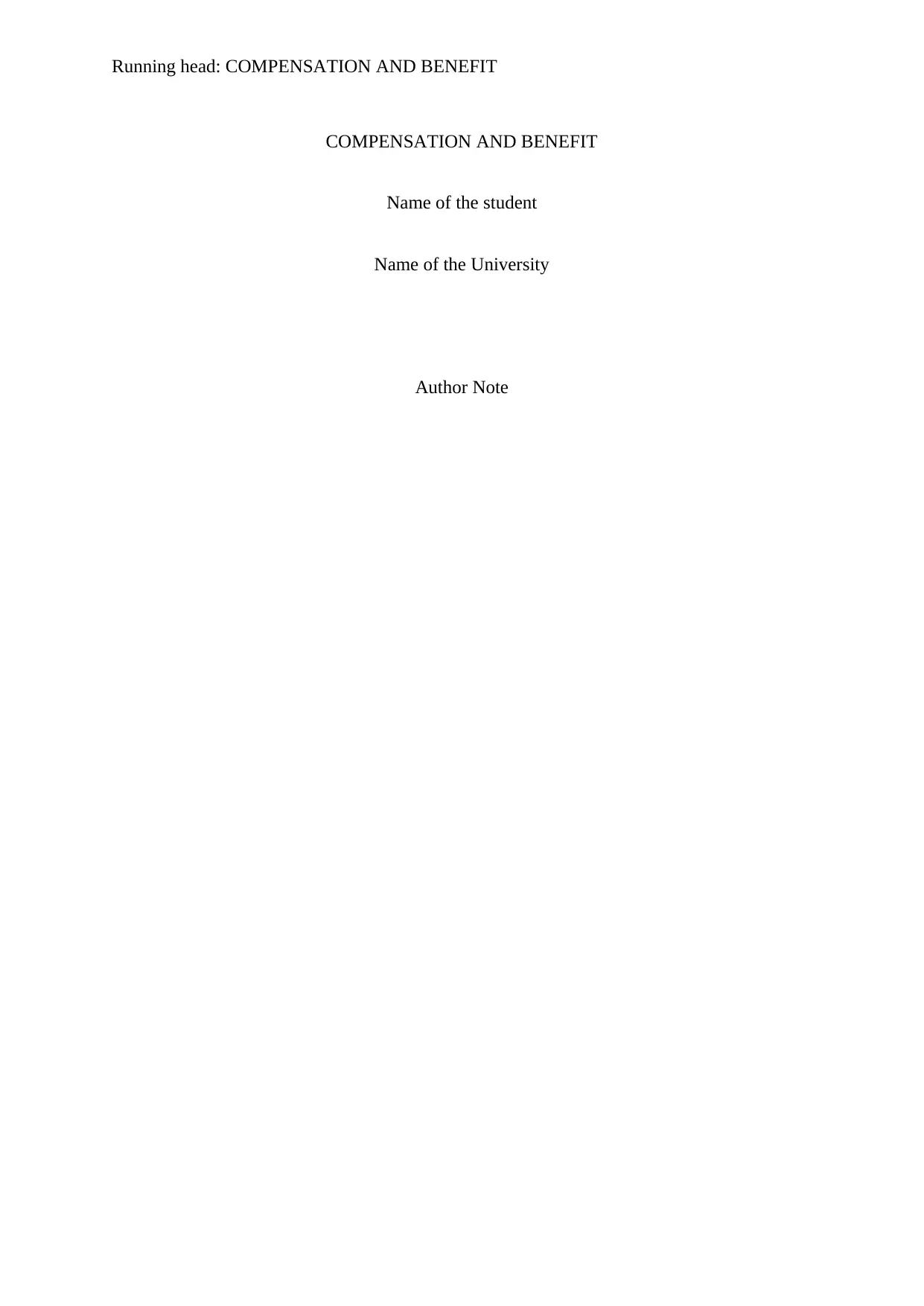
Running head: COMPENSATION AND BENEFIT
COMPENSATION AND BENEFIT
Name of the student
Name of the University
Author Note
COMPENSATION AND BENEFIT
Name of the student
Name of the University
Author Note
Paraphrase This Document
Need a fresh take? Get an instant paraphrase of this document with our AI Paraphraser
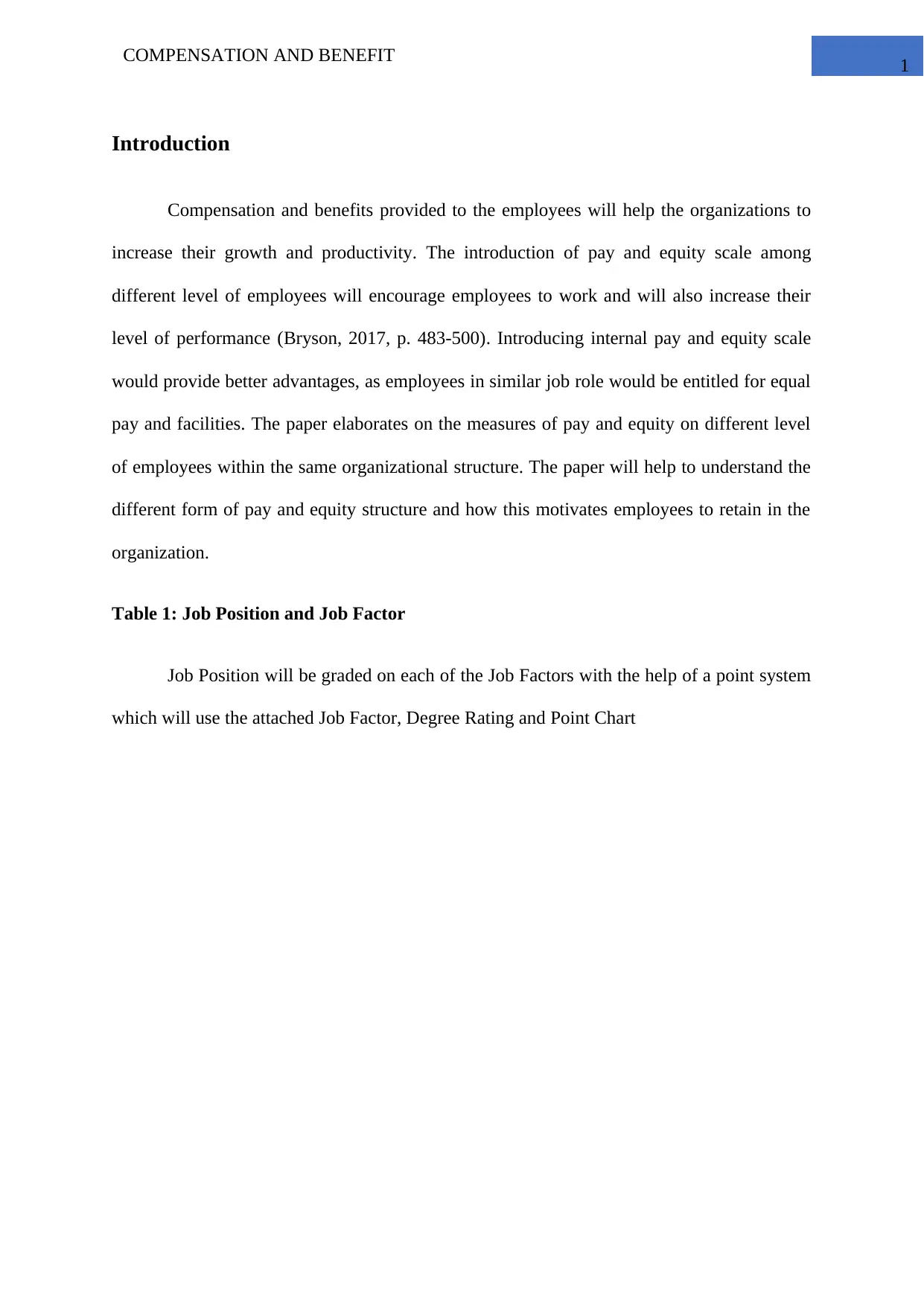
1
COMPENSATION AND BENEFIT
Introduction
Compensation and benefits provided to the employees will help the organizations to
increase their growth and productivity. The introduction of pay and equity scale among
different level of employees will encourage employees to work and will also increase their
level of performance (Bryson, 2017, p. 483-500). Introducing internal pay and equity scale
would provide better advantages, as employees in similar job role would be entitled for equal
pay and facilities. The paper elaborates on the measures of pay and equity on different level
of employees within the same organizational structure. The paper will help to understand the
different form of pay and equity structure and how this motivates employees to retain in the
organization.
Table 1: Job Position and Job Factor
Job Position will be graded on each of the Job Factors with the help of a point system
which will use the attached Job Factor, Degree Rating and Point Chart
COMPENSATION AND BENEFIT
Introduction
Compensation and benefits provided to the employees will help the organizations to
increase their growth and productivity. The introduction of pay and equity scale among
different level of employees will encourage employees to work and will also increase their
level of performance (Bryson, 2017, p. 483-500). Introducing internal pay and equity scale
would provide better advantages, as employees in similar job role would be entitled for equal
pay and facilities. The paper elaborates on the measures of pay and equity on different level
of employees within the same organizational structure. The paper will help to understand the
different form of pay and equity structure and how this motivates employees to retain in the
organization.
Table 1: Job Position and Job Factor
Job Position will be graded on each of the Job Factors with the help of a point system
which will use the attached Job Factor, Degree Rating and Point Chart
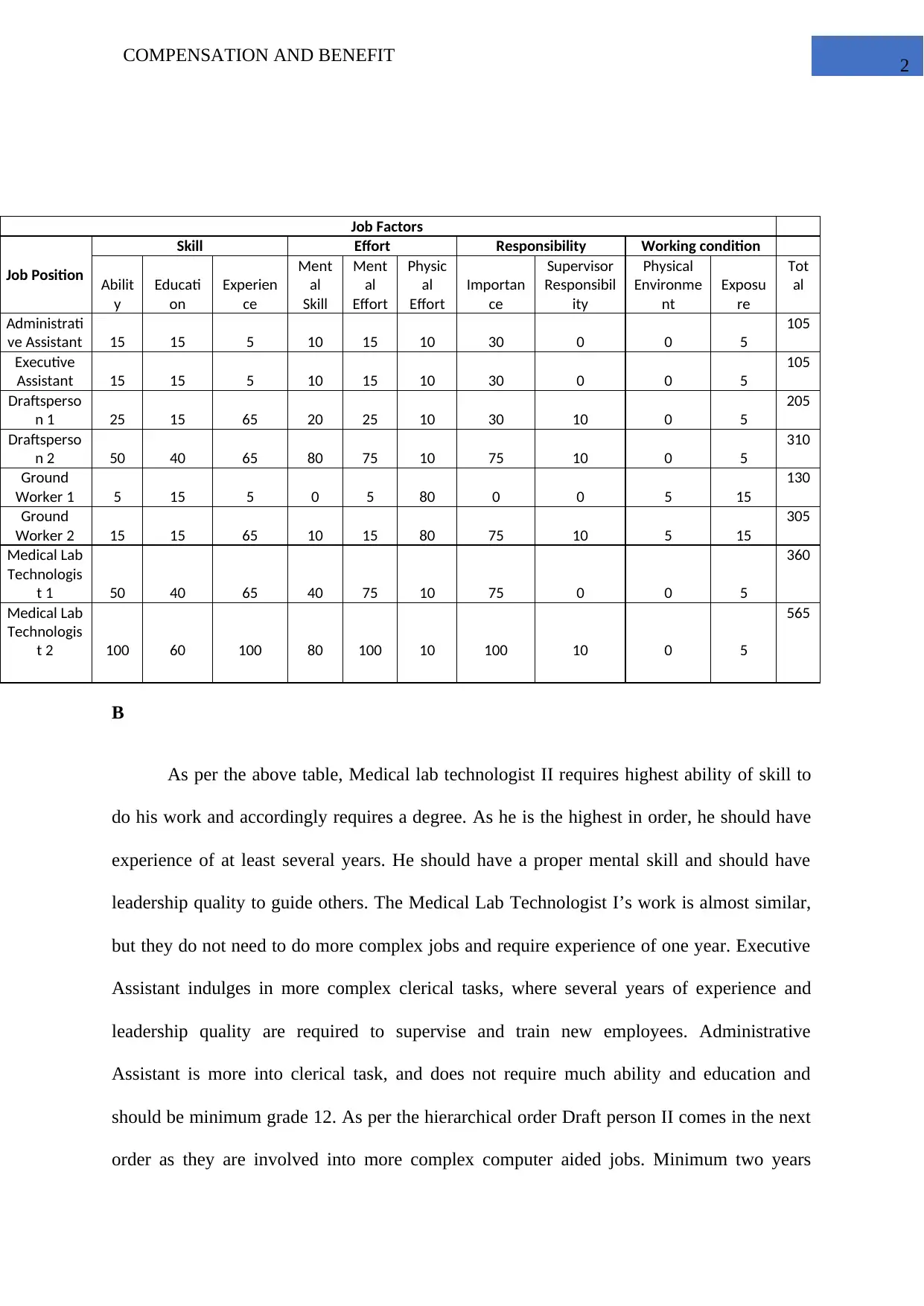
2
COMPENSATION AND BENEFIT
Job Factors
Job Position
Skill Effort Responsibility Working condition
Abilit
y
Educati
on
Experien
ce
Ment
al
Skill
Ment
al
Effort
Physic
al
Effort
Importan
ce
Supervisor
Responsibil
ity
Physical
Environme
nt
Exposu
re
Tot
al
Administrati
ve Assistant 15 15 5 10 15 10 30 0 0 5
105
Executive
Assistant 15 15 5 10 15 10 30 0 0 5
105
Draftsperso
n 1 25 15 65 20 25 10 30 10 0 5
205
Draftsperso
n 2 50 40 65 80 75 10 75 10 0 5
310
Ground
Worker 1 5 15 5 0 5 80 0 0 5 15
130
Ground
Worker 2 15 15 65 10 15 80 75 10 5 15
305
Medical Lab
Technologis
t 1 50 40 65 40 75 10 75 0 0 5
360
Medical Lab
Technologis
t 2 100 60 100 80 100 10 100 10 0 5
565
B
As per the above table, Medical lab technologist II requires highest ability of skill to
do his work and accordingly requires a degree. As he is the highest in order, he should have
experience of at least several years. He should have a proper mental skill and should have
leadership quality to guide others. The Medical Lab Technologist I’s work is almost similar,
but they do not need to do more complex jobs and require experience of one year. Executive
Assistant indulges in more complex clerical tasks, where several years of experience and
leadership quality are required to supervise and train new employees. Administrative
Assistant is more into clerical task, and does not require much ability and education and
should be minimum grade 12. As per the hierarchical order Draft person II comes in the next
order as they are involved into more complex computer aided jobs. Minimum two years
COMPENSATION AND BENEFIT
Job Factors
Job Position
Skill Effort Responsibility Working condition
Abilit
y
Educati
on
Experien
ce
Ment
al
Skill
Ment
al
Effort
Physic
al
Effort
Importan
ce
Supervisor
Responsibil
ity
Physical
Environme
nt
Exposu
re
Tot
al
Administrati
ve Assistant 15 15 5 10 15 10 30 0 0 5
105
Executive
Assistant 15 15 5 10 15 10 30 0 0 5
105
Draftsperso
n 1 25 15 65 20 25 10 30 10 0 5
205
Draftsperso
n 2 50 40 65 80 75 10 75 10 0 5
310
Ground
Worker 1 5 15 5 0 5 80 0 0 5 15
130
Ground
Worker 2 15 15 65 10 15 80 75 10 5 15
305
Medical Lab
Technologis
t 1 50 40 65 40 75 10 75 0 0 5
360
Medical Lab
Technologis
t 2 100 60 100 80 100 10 100 10 0 5
565
B
As per the above table, Medical lab technologist II requires highest ability of skill to
do his work and accordingly requires a degree. As he is the highest in order, he should have
experience of at least several years. He should have a proper mental skill and should have
leadership quality to guide others. The Medical Lab Technologist I’s work is almost similar,
but they do not need to do more complex jobs and require experience of one year. Executive
Assistant indulges in more complex clerical tasks, where several years of experience and
leadership quality are required to supervise and train new employees. Administrative
Assistant is more into clerical task, and does not require much ability and education and
should be minimum grade 12. As per the hierarchical order Draft person II comes in the next
order as they are involved into more complex computer aided jobs. Minimum two years
⊘ This is a preview!⊘
Do you want full access?
Subscribe today to unlock all pages.

Trusted by 1+ million students worldwide
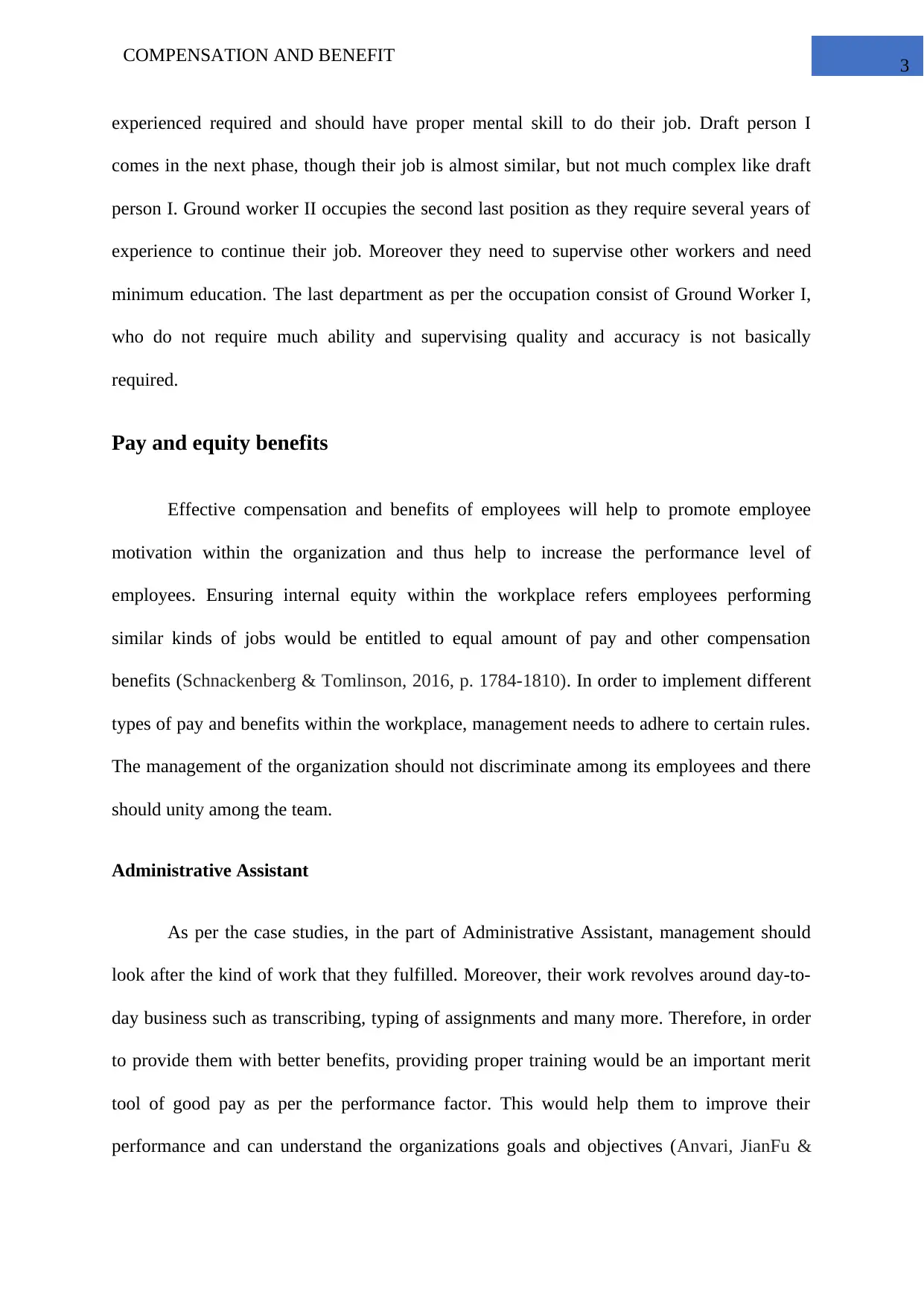
3
COMPENSATION AND BENEFIT
experienced required and should have proper mental skill to do their job. Draft person I
comes in the next phase, though their job is almost similar, but not much complex like draft
person I. Ground worker II occupies the second last position as they require several years of
experience to continue their job. Moreover they need to supervise other workers and need
minimum education. The last department as per the occupation consist of Ground Worker I,
who do not require much ability and supervising quality and accuracy is not basically
required.
Pay and equity benefits
Effective compensation and benefits of employees will help to promote employee
motivation within the organization and thus help to increase the performance level of
employees. Ensuring internal equity within the workplace refers employees performing
similar kinds of jobs would be entitled to equal amount of pay and other compensation
benefits (Schnackenberg & Tomlinson, 2016, p. 1784-1810). In order to implement different
types of pay and benefits within the workplace, management needs to adhere to certain rules.
The management of the organization should not discriminate among its employees and there
should unity among the team.
Administrative Assistant
As per the case studies, in the part of Administrative Assistant, management should
look after the kind of work that they fulfilled. Moreover, their work revolves around day-to-
day business such as transcribing, typing of assignments and many more. Therefore, in order
to provide them with better benefits, providing proper training would be an important merit
tool of good pay as per the performance factor. This would help them to improve their
performance and can understand the organizations goals and objectives (Anvari, JianFu &
COMPENSATION AND BENEFIT
experienced required and should have proper mental skill to do their job. Draft person I
comes in the next phase, though their job is almost similar, but not much complex like draft
person I. Ground worker II occupies the second last position as they require several years of
experience to continue their job. Moreover they need to supervise other workers and need
minimum education. The last department as per the occupation consist of Ground Worker I,
who do not require much ability and supervising quality and accuracy is not basically
required.
Pay and equity benefits
Effective compensation and benefits of employees will help to promote employee
motivation within the organization and thus help to increase the performance level of
employees. Ensuring internal equity within the workplace refers employees performing
similar kinds of jobs would be entitled to equal amount of pay and other compensation
benefits (Schnackenberg & Tomlinson, 2016, p. 1784-1810). In order to implement different
types of pay and benefits within the workplace, management needs to adhere to certain rules.
The management of the organization should not discriminate among its employees and there
should unity among the team.
Administrative Assistant
As per the case studies, in the part of Administrative Assistant, management should
look after the kind of work that they fulfilled. Moreover, their work revolves around day-to-
day business such as transcribing, typing of assignments and many more. Therefore, in order
to provide them with better benefits, providing proper training would be an important merit
tool of good pay as per the performance factor. This would help them to improve their
performance and can understand the organizations goals and objectives (Anvari, JianFu &
Paraphrase This Document
Need a fresh take? Get an instant paraphrase of this document with our AI Paraphraser
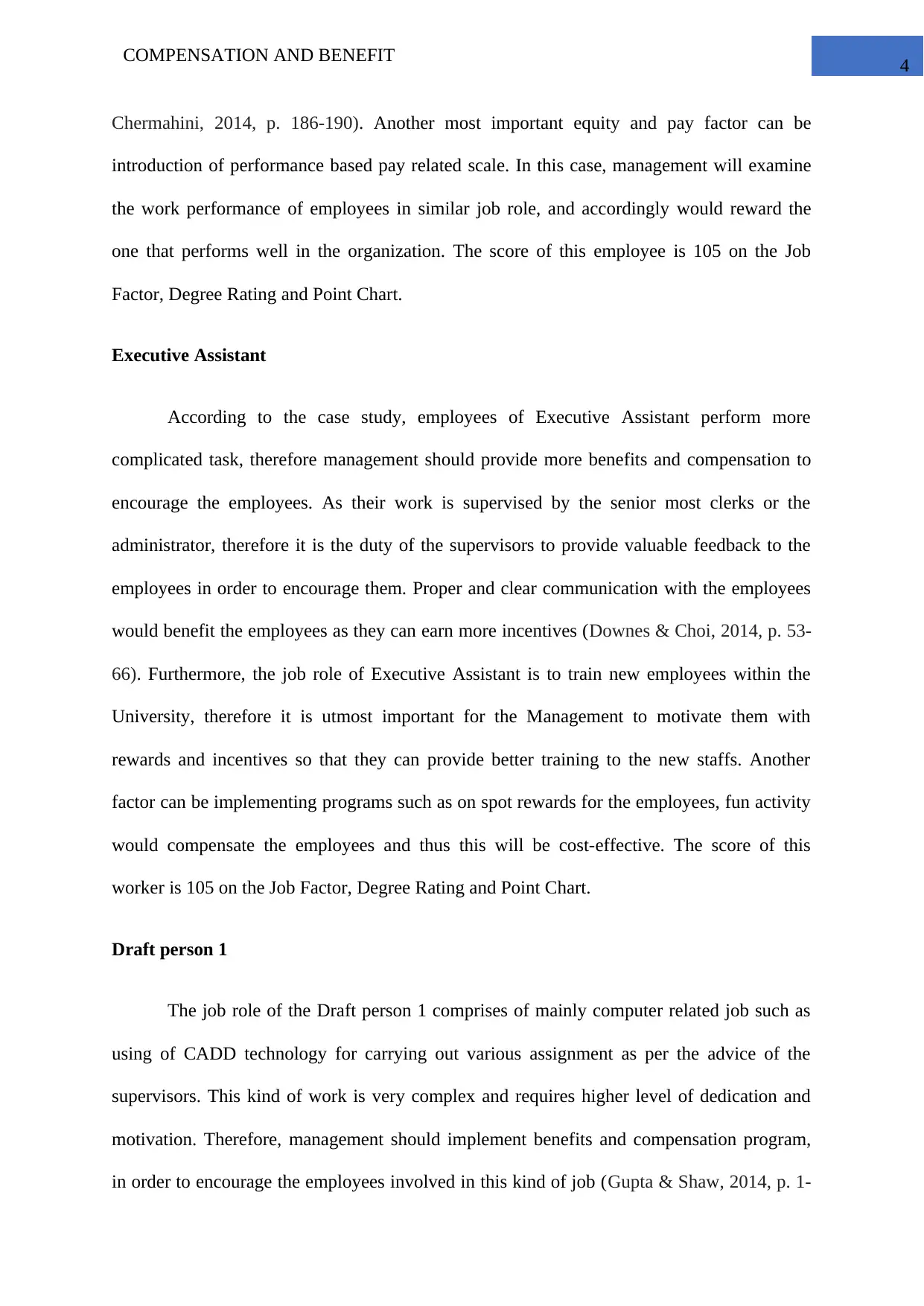
4
COMPENSATION AND BENEFIT
Chermahini, 2014, p. 186-190). Another most important equity and pay factor can be
introduction of performance based pay related scale. In this case, management will examine
the work performance of employees in similar job role, and accordingly would reward the
one that performs well in the organization. The score of this employee is 105 on the Job
Factor, Degree Rating and Point Chart.
Executive Assistant
According to the case study, employees of Executive Assistant perform more
complicated task, therefore management should provide more benefits and compensation to
encourage the employees. As their work is supervised by the senior most clerks or the
administrator, therefore it is the duty of the supervisors to provide valuable feedback to the
employees in order to encourage them. Proper and clear communication with the employees
would benefit the employees as they can earn more incentives (Downes & Choi, 2014, p. 53-
66). Furthermore, the job role of Executive Assistant is to train new employees within the
University, therefore it is utmost important for the Management to motivate them with
rewards and incentives so that they can provide better training to the new staffs. Another
factor can be implementing programs such as on spot rewards for the employees, fun activity
would compensate the employees and thus this will be cost-effective. The score of this
worker is 105 on the Job Factor, Degree Rating and Point Chart.
Draft person 1
The job role of the Draft person 1 comprises of mainly computer related job such as
using of CADD technology for carrying out various assignment as per the advice of the
supervisors. This kind of work is very complex and requires higher level of dedication and
motivation. Therefore, management should implement benefits and compensation program,
in order to encourage the employees involved in this kind of job (Gupta & Shaw, 2014, p. 1-
COMPENSATION AND BENEFIT
Chermahini, 2014, p. 186-190). Another most important equity and pay factor can be
introduction of performance based pay related scale. In this case, management will examine
the work performance of employees in similar job role, and accordingly would reward the
one that performs well in the organization. The score of this employee is 105 on the Job
Factor, Degree Rating and Point Chart.
Executive Assistant
According to the case study, employees of Executive Assistant perform more
complicated task, therefore management should provide more benefits and compensation to
encourage the employees. As their work is supervised by the senior most clerks or the
administrator, therefore it is the duty of the supervisors to provide valuable feedback to the
employees in order to encourage them. Proper and clear communication with the employees
would benefit the employees as they can earn more incentives (Downes & Choi, 2014, p. 53-
66). Furthermore, the job role of Executive Assistant is to train new employees within the
University, therefore it is utmost important for the Management to motivate them with
rewards and incentives so that they can provide better training to the new staffs. Another
factor can be implementing programs such as on spot rewards for the employees, fun activity
would compensate the employees and thus this will be cost-effective. The score of this
worker is 105 on the Job Factor, Degree Rating and Point Chart.
Draft person 1
The job role of the Draft person 1 comprises of mainly computer related job such as
using of CADD technology for carrying out various assignment as per the advice of the
supervisors. This kind of work is very complex and requires higher level of dedication and
motivation. Therefore, management should implement benefits and compensation program,
in order to encourage the employees involved in this kind of job (Gupta & Shaw, 2014, p. 1-
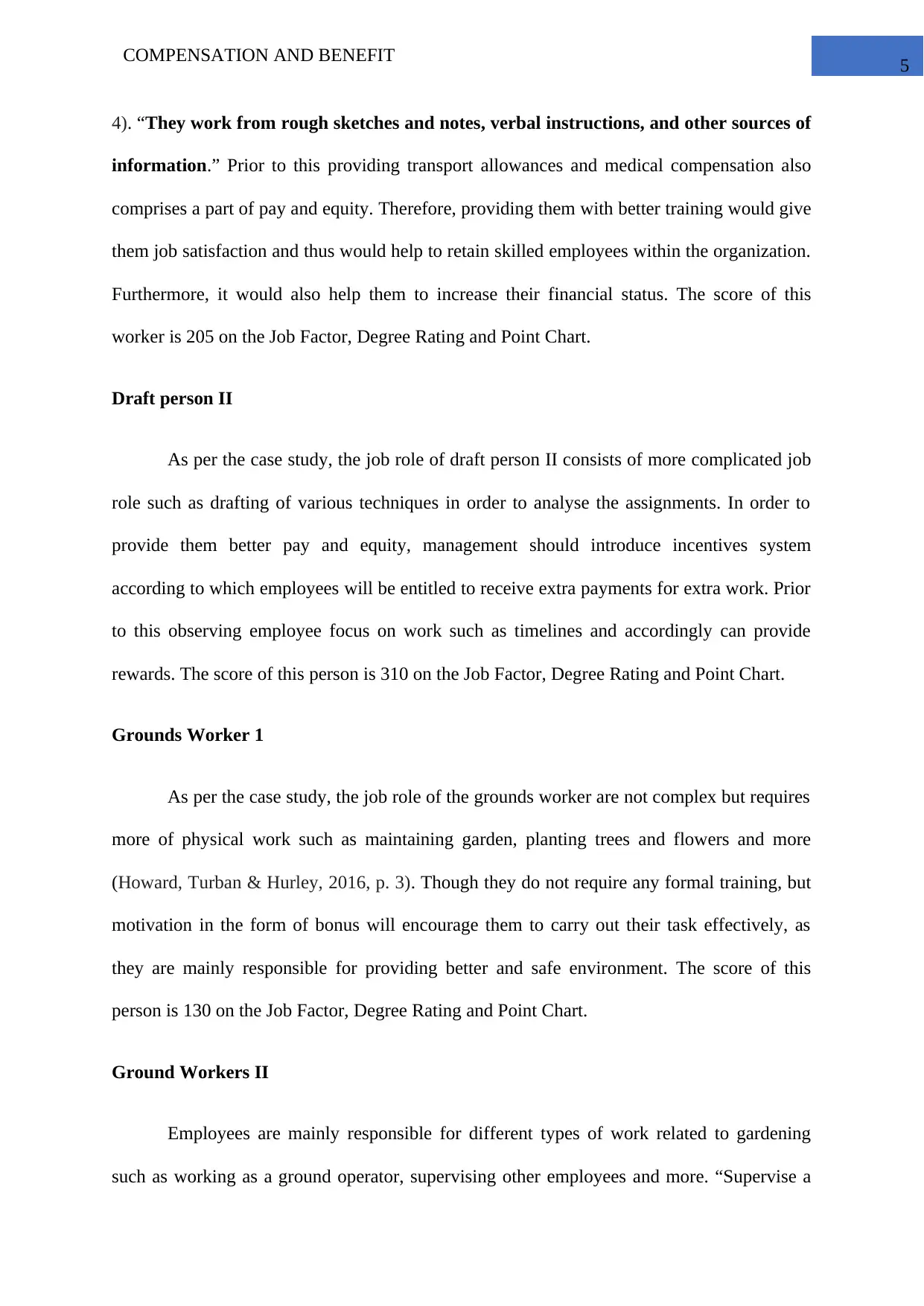
5
COMPENSATION AND BENEFIT
4). “They work from rough sketches and notes, verbal instructions, and other sources of
information.” Prior to this providing transport allowances and medical compensation also
comprises a part of pay and equity. Therefore, providing them with better training would give
them job satisfaction and thus would help to retain skilled employees within the organization.
Furthermore, it would also help them to increase their financial status. The score of this
worker is 205 on the Job Factor, Degree Rating and Point Chart.
Draft person II
As per the case study, the job role of draft person II consists of more complicated job
role such as drafting of various techniques in order to analyse the assignments. In order to
provide them better pay and equity, management should introduce incentives system
according to which employees will be entitled to receive extra payments for extra work. Prior
to this observing employee focus on work such as timelines and accordingly can provide
rewards. The score of this person is 310 on the Job Factor, Degree Rating and Point Chart.
Grounds Worker 1
As per the case study, the job role of the grounds worker are not complex but requires
more of physical work such as maintaining garden, planting trees and flowers and more
(Howard, Turban & Hurley, 2016, p. 3). Though they do not require any formal training, but
motivation in the form of bonus will encourage them to carry out their task effectively, as
they are mainly responsible for providing better and safe environment. The score of this
person is 130 on the Job Factor, Degree Rating and Point Chart.
Ground Workers II
Employees are mainly responsible for different types of work related to gardening
such as working as a ground operator, supervising other employees and more. “Supervise a
COMPENSATION AND BENEFIT
4). “They work from rough sketches and notes, verbal instructions, and other sources of
information.” Prior to this providing transport allowances and medical compensation also
comprises a part of pay and equity. Therefore, providing them with better training would give
them job satisfaction and thus would help to retain skilled employees within the organization.
Furthermore, it would also help them to increase their financial status. The score of this
worker is 205 on the Job Factor, Degree Rating and Point Chart.
Draft person II
As per the case study, the job role of draft person II consists of more complicated job
role such as drafting of various techniques in order to analyse the assignments. In order to
provide them better pay and equity, management should introduce incentives system
according to which employees will be entitled to receive extra payments for extra work. Prior
to this observing employee focus on work such as timelines and accordingly can provide
rewards. The score of this person is 310 on the Job Factor, Degree Rating and Point Chart.
Grounds Worker 1
As per the case study, the job role of the grounds worker are not complex but requires
more of physical work such as maintaining garden, planting trees and flowers and more
(Howard, Turban & Hurley, 2016, p. 3). Though they do not require any formal training, but
motivation in the form of bonus will encourage them to carry out their task effectively, as
they are mainly responsible for providing better and safe environment. The score of this
person is 130 on the Job Factor, Degree Rating and Point Chart.
Ground Workers II
Employees are mainly responsible for different types of work related to gardening
such as working as a ground operator, supervising other employees and more. “Supervise a
⊘ This is a preview!⊘
Do you want full access?
Subscribe today to unlock all pages.

Trusted by 1+ million students worldwide
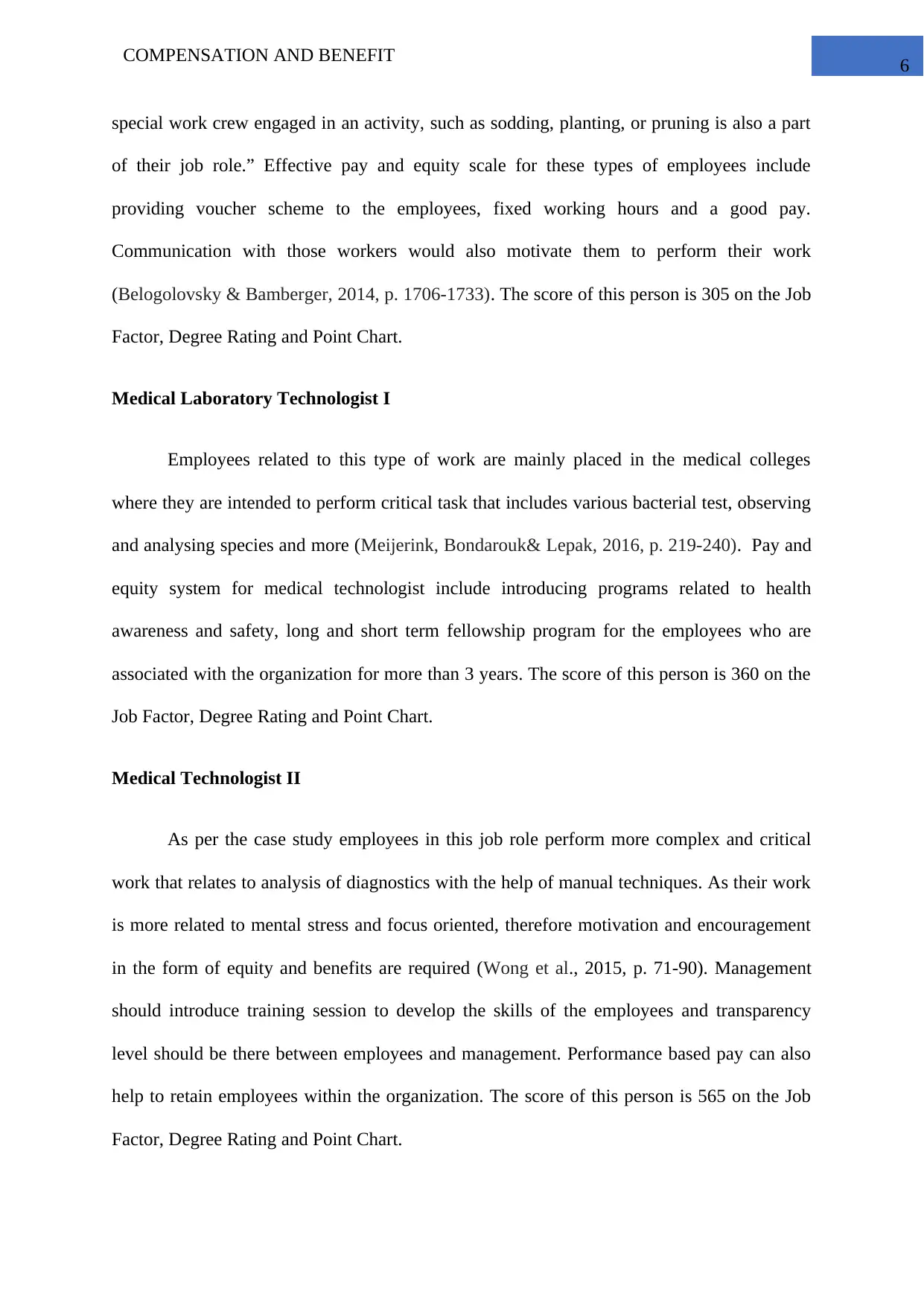
6
COMPENSATION AND BENEFIT
special work crew engaged in an activity, such as sodding, planting, or pruning is also a part
of their job role.” Effective pay and equity scale for these types of employees include
providing voucher scheme to the employees, fixed working hours and a good pay.
Communication with those workers would also motivate them to perform their work
(Belogolovsky & Bamberger, 2014, p. 1706-1733). The score of this person is 305 on the Job
Factor, Degree Rating and Point Chart.
Medical Laboratory Technologist I
Employees related to this type of work are mainly placed in the medical colleges
where they are intended to perform critical task that includes various bacterial test, observing
and analysing species and more (Meijerink, Bondarouk& Lepak, 2016, p. 219-240). Pay and
equity system for medical technologist include introducing programs related to health
awareness and safety, long and short term fellowship program for the employees who are
associated with the organization for more than 3 years. The score of this person is 360 on the
Job Factor, Degree Rating and Point Chart.
Medical Technologist II
As per the case study employees in this job role perform more complex and critical
work that relates to analysis of diagnostics with the help of manual techniques. As their work
is more related to mental stress and focus oriented, therefore motivation and encouragement
in the form of equity and benefits are required (Wong et al., 2015, p. 71-90). Management
should introduce training session to develop the skills of the employees and transparency
level should be there between employees and management. Performance based pay can also
help to retain employees within the organization. The score of this person is 565 on the Job
Factor, Degree Rating and Point Chart.
COMPENSATION AND BENEFIT
special work crew engaged in an activity, such as sodding, planting, or pruning is also a part
of their job role.” Effective pay and equity scale for these types of employees include
providing voucher scheme to the employees, fixed working hours and a good pay.
Communication with those workers would also motivate them to perform their work
(Belogolovsky & Bamberger, 2014, p. 1706-1733). The score of this person is 305 on the Job
Factor, Degree Rating and Point Chart.
Medical Laboratory Technologist I
Employees related to this type of work are mainly placed in the medical colleges
where they are intended to perform critical task that includes various bacterial test, observing
and analysing species and more (Meijerink, Bondarouk& Lepak, 2016, p. 219-240). Pay and
equity system for medical technologist include introducing programs related to health
awareness and safety, long and short term fellowship program for the employees who are
associated with the organization for more than 3 years. The score of this person is 360 on the
Job Factor, Degree Rating and Point Chart.
Medical Technologist II
As per the case study employees in this job role perform more complex and critical
work that relates to analysis of diagnostics with the help of manual techniques. As their work
is more related to mental stress and focus oriented, therefore motivation and encouragement
in the form of equity and benefits are required (Wong et al., 2015, p. 71-90). Management
should introduce training session to develop the skills of the employees and transparency
level should be there between employees and management. Performance based pay can also
help to retain employees within the organization. The score of this person is 565 on the Job
Factor, Degree Rating and Point Chart.
Paraphrase This Document
Need a fresh take? Get an instant paraphrase of this document with our AI Paraphraser
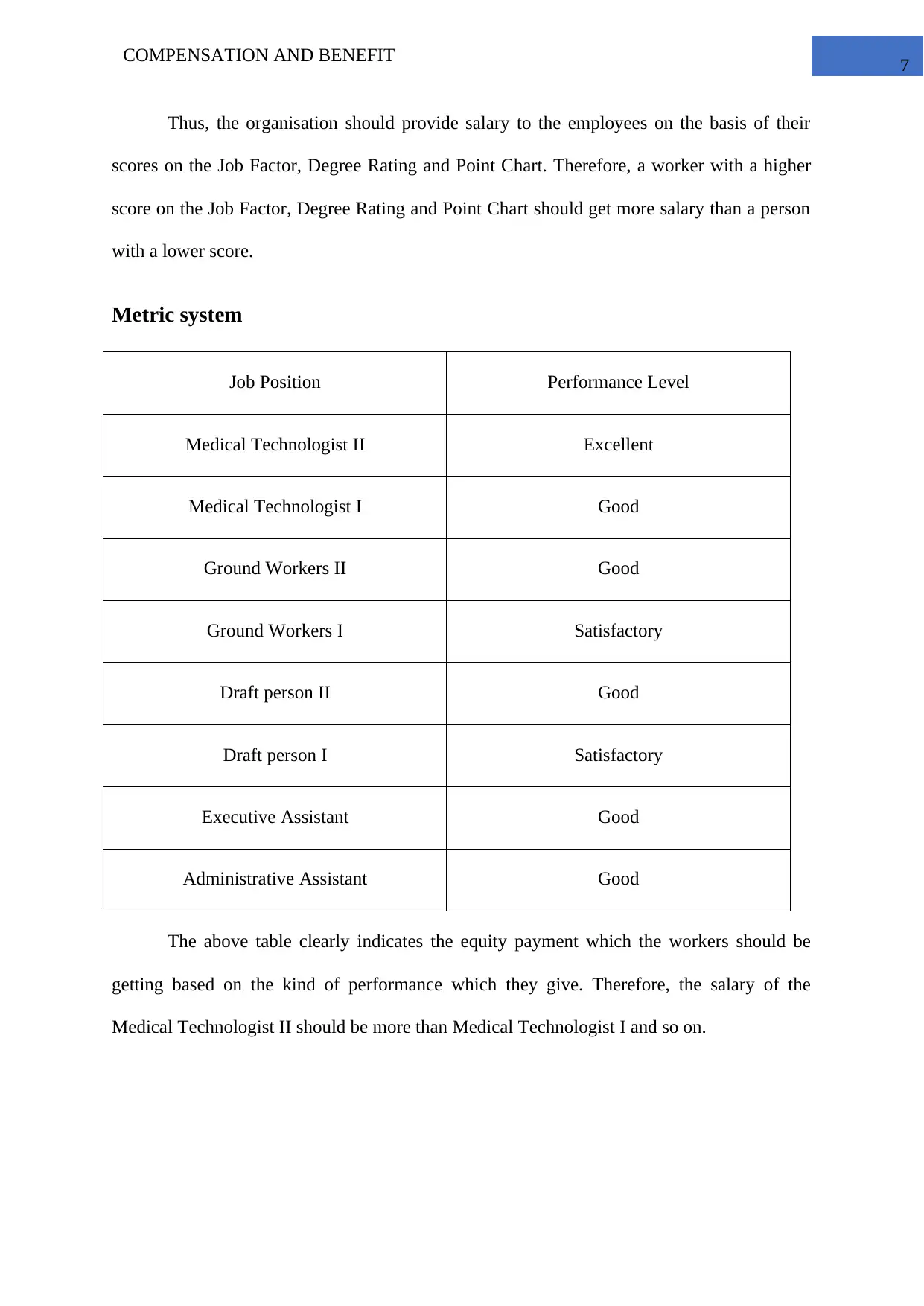
7
COMPENSATION AND BENEFIT
Thus, the organisation should provide salary to the employees on the basis of their
scores on the Job Factor, Degree Rating and Point Chart. Therefore, a worker with a higher
score on the Job Factor, Degree Rating and Point Chart should get more salary than a person
with a lower score.
Metric system
Job Position Performance Level
Medical Technologist II Excellent
Medical Technologist I Good
Ground Workers II Good
Ground Workers I Satisfactory
Draft person II Good
Draft person I Satisfactory
Executive Assistant Good
Administrative Assistant Good
The above table clearly indicates the equity payment which the workers should be
getting based on the kind of performance which they give. Therefore, the salary of the
Medical Technologist II should be more than Medical Technologist I and so on.
COMPENSATION AND BENEFIT
Thus, the organisation should provide salary to the employees on the basis of their
scores on the Job Factor, Degree Rating and Point Chart. Therefore, a worker with a higher
score on the Job Factor, Degree Rating and Point Chart should get more salary than a person
with a lower score.
Metric system
Job Position Performance Level
Medical Technologist II Excellent
Medical Technologist I Good
Ground Workers II Good
Ground Workers I Satisfactory
Draft person II Good
Draft person I Satisfactory
Executive Assistant Good
Administrative Assistant Good
The above table clearly indicates the equity payment which the workers should be
getting based on the kind of performance which they give. Therefore, the salary of the
Medical Technologist II should be more than Medical Technologist I and so on.
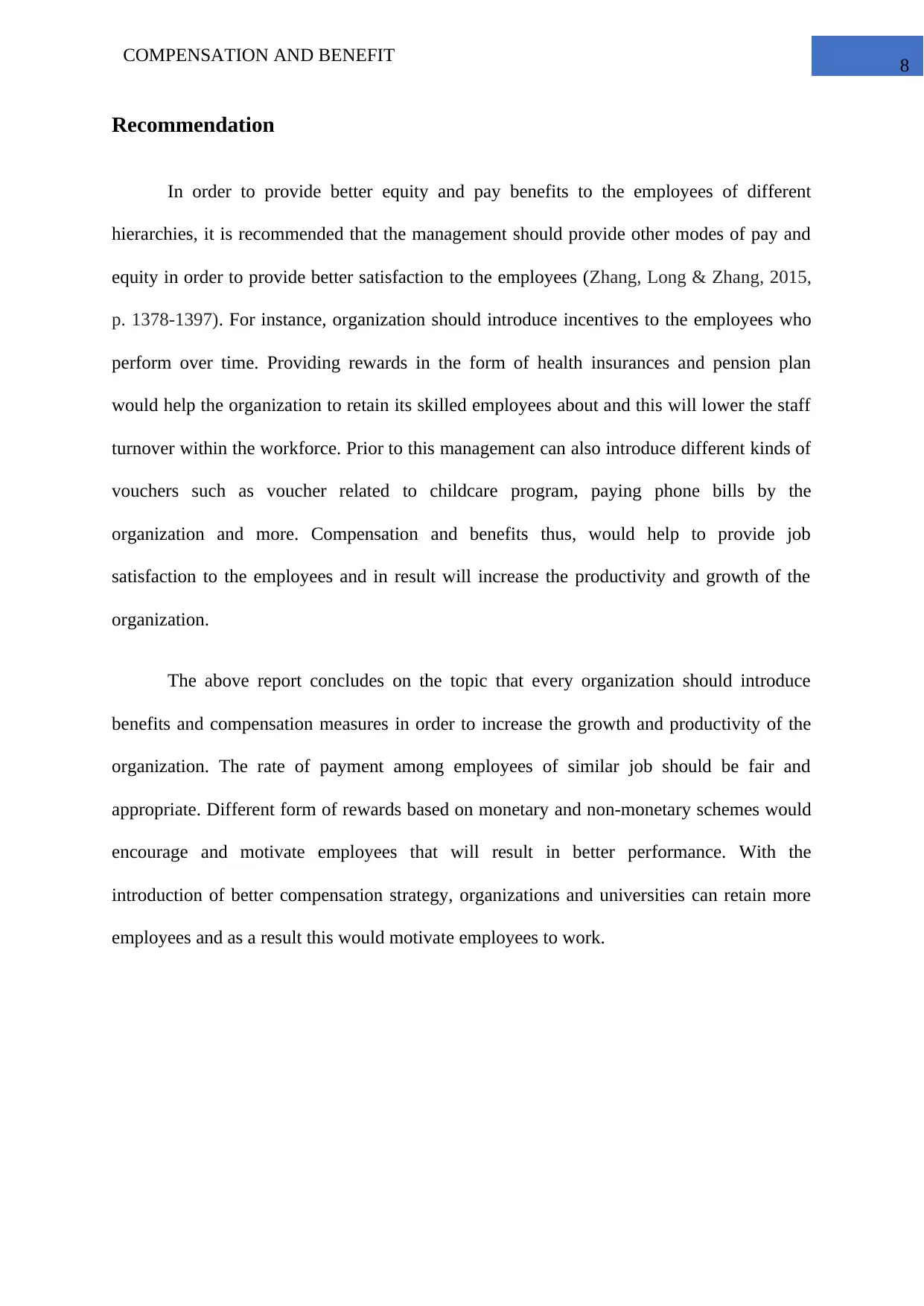
8
COMPENSATION AND BENEFIT
Recommendation
In order to provide better equity and pay benefits to the employees of different
hierarchies, it is recommended that the management should provide other modes of pay and
equity in order to provide better satisfaction to the employees (Zhang, Long & Zhang, 2015,
p. 1378-1397). For instance, organization should introduce incentives to the employees who
perform over time. Providing rewards in the form of health insurances and pension plan
would help the organization to retain its skilled employees about and this will lower the staff
turnover within the workforce. Prior to this management can also introduce different kinds of
vouchers such as voucher related to childcare program, paying phone bills by the
organization and more. Compensation and benefits thus, would help to provide job
satisfaction to the employees and in result will increase the productivity and growth of the
organization.
The above report concludes on the topic that every organization should introduce
benefits and compensation measures in order to increase the growth and productivity of the
organization. The rate of payment among employees of similar job should be fair and
appropriate. Different form of rewards based on monetary and non-monetary schemes would
encourage and motivate employees that will result in better performance. With the
introduction of better compensation strategy, organizations and universities can retain more
employees and as a result this would motivate employees to work.
COMPENSATION AND BENEFIT
Recommendation
In order to provide better equity and pay benefits to the employees of different
hierarchies, it is recommended that the management should provide other modes of pay and
equity in order to provide better satisfaction to the employees (Zhang, Long & Zhang, 2015,
p. 1378-1397). For instance, organization should introduce incentives to the employees who
perform over time. Providing rewards in the form of health insurances and pension plan
would help the organization to retain its skilled employees about and this will lower the staff
turnover within the workforce. Prior to this management can also introduce different kinds of
vouchers such as voucher related to childcare program, paying phone bills by the
organization and more. Compensation and benefits thus, would help to provide job
satisfaction to the employees and in result will increase the productivity and growth of the
organization.
The above report concludes on the topic that every organization should introduce
benefits and compensation measures in order to increase the growth and productivity of the
organization. The rate of payment among employees of similar job should be fair and
appropriate. Different form of rewards based on monetary and non-monetary schemes would
encourage and motivate employees that will result in better performance. With the
introduction of better compensation strategy, organizations and universities can retain more
employees and as a result this would motivate employees to work.
⊘ This is a preview!⊘
Do you want full access?
Subscribe today to unlock all pages.

Trusted by 1+ million students worldwide
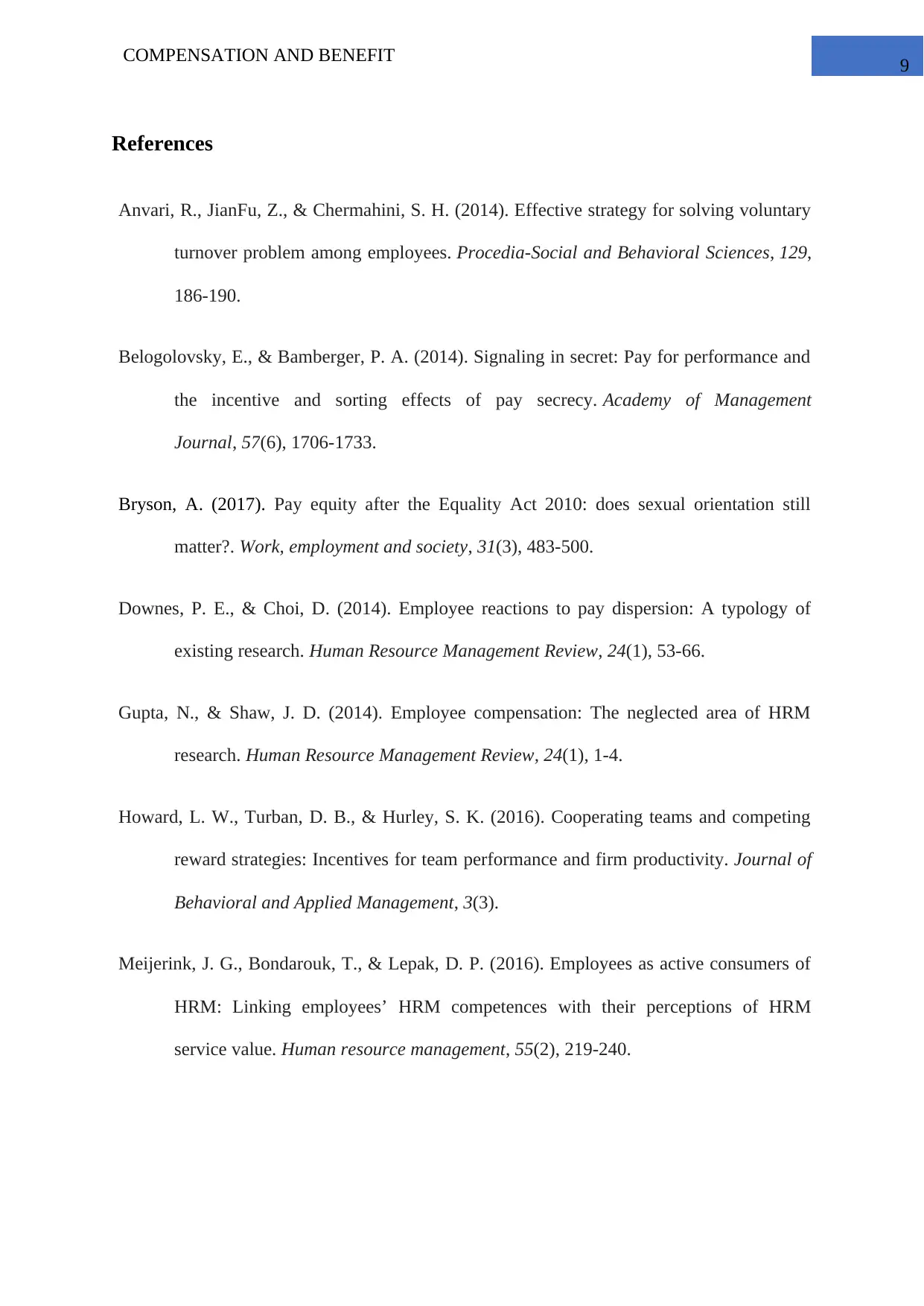
9
COMPENSATION AND BENEFIT
References
Anvari, R., JianFu, Z., & Chermahini, S. H. (2014). Effective strategy for solving voluntary
turnover problem among employees. Procedia-Social and Behavioral Sciences, 129,
186-190.
Belogolovsky, E., & Bamberger, P. A. (2014). Signaling in secret: Pay for performance and
the incentive and sorting effects of pay secrecy. Academy of Management
Journal, 57(6), 1706-1733.
Bryson, A. (2017). Pay equity after the Equality Act 2010: does sexual orientation still
matter?. Work, employment and society, 31(3), 483-500.
Downes, P. E., & Choi, D. (2014). Employee reactions to pay dispersion: A typology of
existing research. Human Resource Management Review, 24(1), 53-66.
Gupta, N., & Shaw, J. D. (2014). Employee compensation: The neglected area of HRM
research. Human Resource Management Review, 24(1), 1-4.
Howard, L. W., Turban, D. B., & Hurley, S. K. (2016). Cooperating teams and competing
reward strategies: Incentives for team performance and firm productivity. Journal of
Behavioral and Applied Management, 3(3).
Meijerink, J. G., Bondarouk, T., & Lepak, D. P. (2016). Employees as active consumers of
HRM: Linking employees’ HRM competences with their perceptions of HRM
service value. Human resource management, 55(2), 219-240.
COMPENSATION AND BENEFIT
References
Anvari, R., JianFu, Z., & Chermahini, S. H. (2014). Effective strategy for solving voluntary
turnover problem among employees. Procedia-Social and Behavioral Sciences, 129,
186-190.
Belogolovsky, E., & Bamberger, P. A. (2014). Signaling in secret: Pay for performance and
the incentive and sorting effects of pay secrecy. Academy of Management
Journal, 57(6), 1706-1733.
Bryson, A. (2017). Pay equity after the Equality Act 2010: does sexual orientation still
matter?. Work, employment and society, 31(3), 483-500.
Downes, P. E., & Choi, D. (2014). Employee reactions to pay dispersion: A typology of
existing research. Human Resource Management Review, 24(1), 53-66.
Gupta, N., & Shaw, J. D. (2014). Employee compensation: The neglected area of HRM
research. Human Resource Management Review, 24(1), 1-4.
Howard, L. W., Turban, D. B., & Hurley, S. K. (2016). Cooperating teams and competing
reward strategies: Incentives for team performance and firm productivity. Journal of
Behavioral and Applied Management, 3(3).
Meijerink, J. G., Bondarouk, T., & Lepak, D. P. (2016). Employees as active consumers of
HRM: Linking employees’ HRM competences with their perceptions of HRM
service value. Human resource management, 55(2), 219-240.
Paraphrase This Document
Need a fresh take? Get an instant paraphrase of this document with our AI Paraphraser
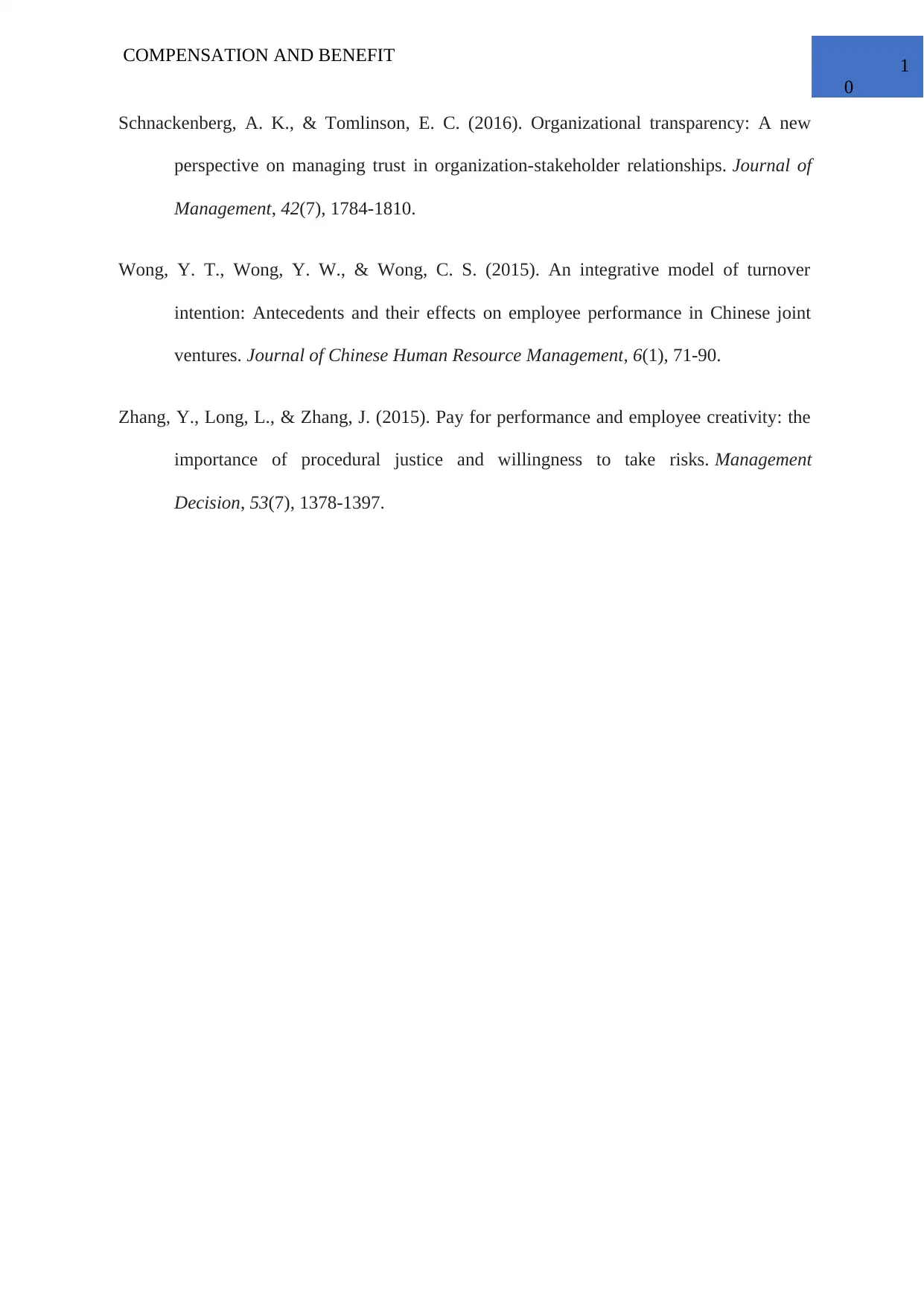
1
0
COMPENSATION AND BENEFIT
Schnackenberg, A. K., & Tomlinson, E. C. (2016). Organizational transparency: A new
perspective on managing trust in organization-stakeholder relationships. Journal of
Management, 42(7), 1784-1810.
Wong, Y. T., Wong, Y. W., & Wong, C. S. (2015). An integrative model of turnover
intention: Antecedents and their effects on employee performance in Chinese joint
ventures. Journal of Chinese Human Resource Management, 6(1), 71-90.
Zhang, Y., Long, L., & Zhang, J. (2015). Pay for performance and employee creativity: the
importance of procedural justice and willingness to take risks. Management
Decision, 53(7), 1378-1397.
0
COMPENSATION AND BENEFIT
Schnackenberg, A. K., & Tomlinson, E. C. (2016). Organizational transparency: A new
perspective on managing trust in organization-stakeholder relationships. Journal of
Management, 42(7), 1784-1810.
Wong, Y. T., Wong, Y. W., & Wong, C. S. (2015). An integrative model of turnover
intention: Antecedents and their effects on employee performance in Chinese joint
ventures. Journal of Chinese Human Resource Management, 6(1), 71-90.
Zhang, Y., Long, L., & Zhang, J. (2015). Pay for performance and employee creativity: the
importance of procedural justice and willingness to take risks. Management
Decision, 53(7), 1378-1397.
1 out of 11
Related Documents
Your All-in-One AI-Powered Toolkit for Academic Success.
+13062052269
info@desklib.com
Available 24*7 on WhatsApp / Email
![[object Object]](/_next/static/media/star-bottom.7253800d.svg)
Unlock your academic potential
Copyright © 2020–2025 A2Z Services. All Rights Reserved. Developed and managed by ZUCOL.





